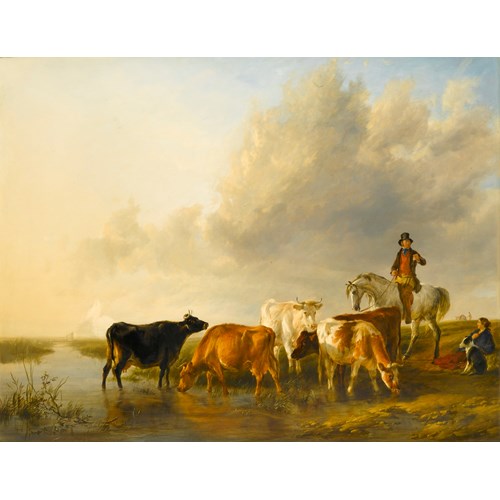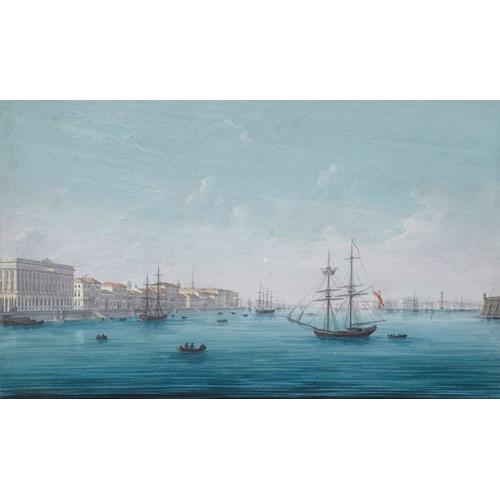Marketplace
View of a Russian Provincial City
Sokrat Maksimovich Vorobiev
View of a Russian Provincial City
Epoque 1850-1900, 19th century
Origine Russia, Lithuania
Medium Pencil, Watercolour on paper
Dimension 40.6 x 57.8 cm (16 x 22³/₄ inches)
In this refined and sensitive depiction of a Russian townscape by Sokrat Maksimovich Vorobiev, one sees the juxtaposition of a grandly fortified provincial city in the background of the composition with a close up view of humble cottages on the right. The walls and buildings of the citadel stretch along the horizon with gleaming onion domes and turrets outlined against a cloudy sky. The cottages made of timber with peaked roofs are clustered together amidst trees and dense foliage. Variations in colouring further distinguish the urban centre, painted in pale washes, from the rural outskirts, which have a darker, more shadowy quality.
Near the cottages, a rickety fence and empty cart stand in the yard and laundry hangs on the line, adding to the homely disarray and giving the painting the added charm of a genre scene. Several figures traverse on foot or ride through the landscape along a dusty path leading past the cottages on the right and a lake on the left towards the city’s gates. They appear to be country folk as they are simply dressed, the gentlemen wearing dark hats and the women covering their hair with white kerchiefs.
With its elegant architecture built atop the gently rolling hills bordering the lake, this provincial city could be one of many historic towns dotted around Russia. The cities comprising the ‘Golden Ring’ to the northeast of Moscow, such as Rostov on the shores of Lake Nero in Yaroslav Oblast, are particularly picturesque and prominently feature the famous onion domes that are portrayed in Vorobiev’s watercolour.
In View of a Russian Provincial City, Vorobiev follows the example of artists such as Ivan Ivanov (1779-1848) and Andrey Yefimovich Martynov who travelled around Russia in the early part of the nineteenth century painting poetic views of their native country, inhabited by people calmly going about their daily lives. In their works, as in Vorobiev’s, landscape and genre elements are intertwined to create harmonious images. Yevgenia Petrova writes of the vedutisti of the early nineteenth century, including Vorobiev: ‘Their synchretic [sic] perception of the world clearly predominates over the synthetic. Tightly linked and mutually subordinated to one another, genre scenes and landscapes remained in such a relationship for a long period of time in Russian art’.¹
Vorobiev was a landscape artist who painted views of his native Russia as well as Italy. He became professor at the Academy of Fine Arts, St. Petersburg, in 1872, and his students included Ivan Ivanovich Shishkin, Julius Sergius von Klever (1850-1924) and Ivan Meshcherskiy (1834-1902).
Near the cottages, a rickety fence and empty cart stand in the yard and laundry hangs on the line, adding to the homely disarray and giving the painting the added charm of a genre scene. Several figures traverse on foot or ride through the landscape along a dusty path leading past the cottages on the right and a lake on the left towards the city’s gates. They appear to be country folk as they are simply dressed, the gentlemen wearing dark hats and the women covering their hair with white kerchiefs.
With its elegant architecture built atop the gently rolling hills bordering the lake, this provincial city could be one of many historic towns dotted around Russia. The cities comprising the ‘Golden Ring’ to the northeast of Moscow, such as Rostov on the shores of Lake Nero in Yaroslav Oblast, are particularly picturesque and prominently feature the famous onion domes that are portrayed in Vorobiev’s watercolour.
In View of a Russian Provincial City, Vorobiev follows the example of artists such as Ivan Ivanov (1779-1848) and Andrey Yefimovich Martynov who travelled around Russia in the early part of the nineteenth century painting poetic views of their native country, inhabited by people calmly going about their daily lives. In their works, as in Vorobiev’s, landscape and genre elements are intertwined to create harmonious images. Yevgenia Petrova writes of the vedutisti of the early nineteenth century, including Vorobiev: ‘Their synchretic [sic] perception of the world clearly predominates over the synthetic. Tightly linked and mutually subordinated to one another, genre scenes and landscapes remained in such a relationship for a long period of time in Russian art’.¹
Vorobiev was a landscape artist who painted views of his native Russia as well as Italy. He became professor at the Academy of Fine Arts, St. Petersburg, in 1872, and his students included Ivan Ivanovich Shishkin, Julius Sergius von Klever (1850-1924) and Ivan Meshcherskiy (1834-1902).
Epoque: 1850-1900, 19th century
Origine: Russia, Lithuania
Medium: Pencil, Watercolour on paper
Dimension: 40.6 x 57.8 cm (16 x 22³/₄ inches)
Plus d'œuvres d'art de la Galerie









